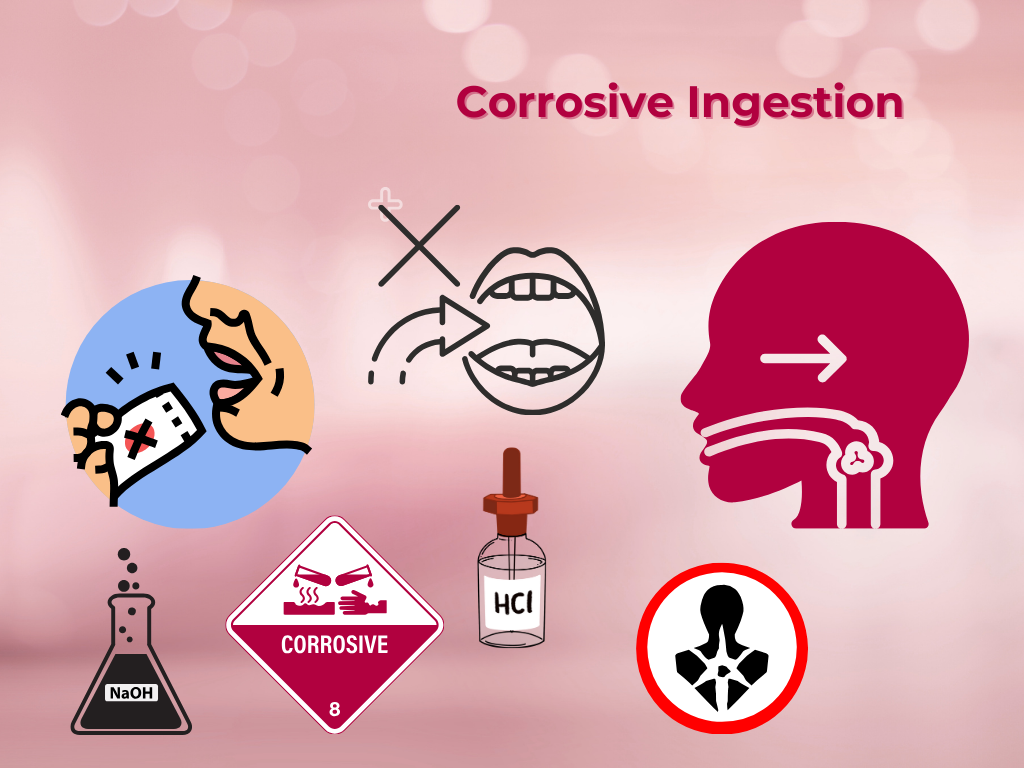Corrosive ingestion refers to the consumption of substances that can cause damage to the mucous membranes and tissues of the gastrointestinal tract.
Types of Corrosives
1. Acids: Examples include hydrochloric acid, sulfuric acid, and nitric acid.
2. Alkalis: Examples include sodium hydroxide, potassium hydroxide, and ammonia.
Epidemiology
1. Accidental ingestion: More common in children.
2. Intentional ingestion: More common in adults, often as a means of self-harm.
Pathophysiology and Zargar Grading
1. Tissue damage: Corrosives can cause liquefaction necrosis (alkalis) or coagulative necrosis (acids)
2. Zargar grading: A classification system used to grade the severity of mucosal injuries:
- Grade 0: Normal mucosa
- Grade 1: Edema and hyperemia
- Grade 2A: Friability, hemorrhages, erosions, blisters, and exudates
- Grade 2B: Grade 2A findings with deep or circumferential ulcers
- Grade 3A: Small scattered areas of necrosis
- Grade 3B: Extensive necrosis
Symptoms and Signs
1. Oral and pharyngeal pain: Pain in the mouth, throat, and chest.
2. Dysphagia: Difficulty swallowing.
3. Vomiting: May be bloody.
4. Abdominal pain: Severe abdominal pain
Investigations
1. Oesophagogastroduodenoscopy (OGD): Crucial for assessing the extent of injury.
2. Contrast studies: May be used to evaluate for complications like perforation or stricture.
Role and Timing of OGD
1. Timing: OGD is typically performed within 12-48 hours after ingestion.
2. Role: OGD helps determine the extent and severity of the corrosive injury.
Role and Timing of Contrast Studies
1. Timing: Contrast studies may be performed if there's suspicion of perforation or if OGD is not feasible.
2. Role: Contrast studies can help identify complications like perforation or stricture.
Complications
1. Stricture formation: Narrowing of the esophagus or other parts of the gastrointestinal tract.
2. Perforation: Hole in the wall of the esophagus or stomach.
2. Infection: Bacterial or fungal infections can occur.
Timing of Oesophageal Dilation for Stricture
1. Early dilation: May be considered in some cases, but often delayed until the acute injury has healed.
2. Repeated dilation: May be necessary to maintain patency of the esophagus.
Management Options
-
Immediate care:
Supportive care, including management of pain, hydration, and nutrition.
-
Endoscopic dilation:
May be necessary for strictures.
-
Surgery:
May be required for perforation, severe injury, or complications like stricture.
-
Long-term follow-up:
Regular follow-up is necessary to monitor for complications and manage any long-term effects.
The management of corrosive ingestion requires a multidisciplinary approach, involving emergency medicine, gastroenterology, and surgery.
Share Post On:
Recent Posts
-
Nuggets of ORL-RHINOLOGY
-
Nuggets of Otorhinolaryngology-Basic sciences
-
Anatomy of the Muscles of the Soft Palate
-
Ethmoidal Arteries Ligation for Epistaxis
-
Submucous Cleft Palate (SMCP)
-
Approach to Ligation of the External Carotid Artery
-
Approach to Managing a 3-Year-Old Boy with a Foreign Body in the nasal cavity.
-
Approach to Managing a 3-Year-Old Boy with a Foreign Body impacted in the ear canal.
-
Endoscopic Sphenopalatine Artery Ligation (ESPAL) for Epistaxis
-
Surgical Management of Epistaxis
-
Technique of Incision and Drainage of Septal Hematoma/Septal Abscess
-
Upper Aerodigestive Tract Foreign Body Impaction
-
Incision and Drainage of Hematoma Auris
-
Rigid Bronchoscopy for Retrieval of Foreign Bodies in Children
-
Foreign Body Impaction in the Larynx, Trachea, and Bronchi
-
Leadership Position is a Tool, not a Trophy
-
Carcinoma of the Oropharynx
-
Peritonsillar Abscess
-
Ethics of Doctor-Patient Relationship
-
Doctor-Patient Relationship Case Scenarios
-
Asymmetrical Tonsils and Approach to Evaluation and Management
-
Nasal Polyposis
-
Rigid Oesophagoscopy and Complication
-
Anatomy of Oesophagus
-
Stridor, Snoring, Stertor And Wheezing: How They Compare
-
Temporomandibular Joint (TMJ)
-
Otoacoustic Emissions
-
Tympanometry
-
Functional Endoscopic Sinus Surgery (FESS)
-
Tracheostomy
Categories
Get in Touch
Read doctor-produced health and medical information written for you to make informed decisions about your health concerns.


